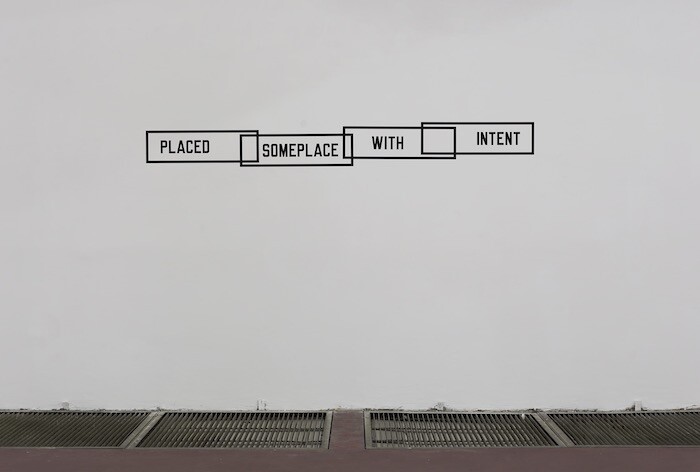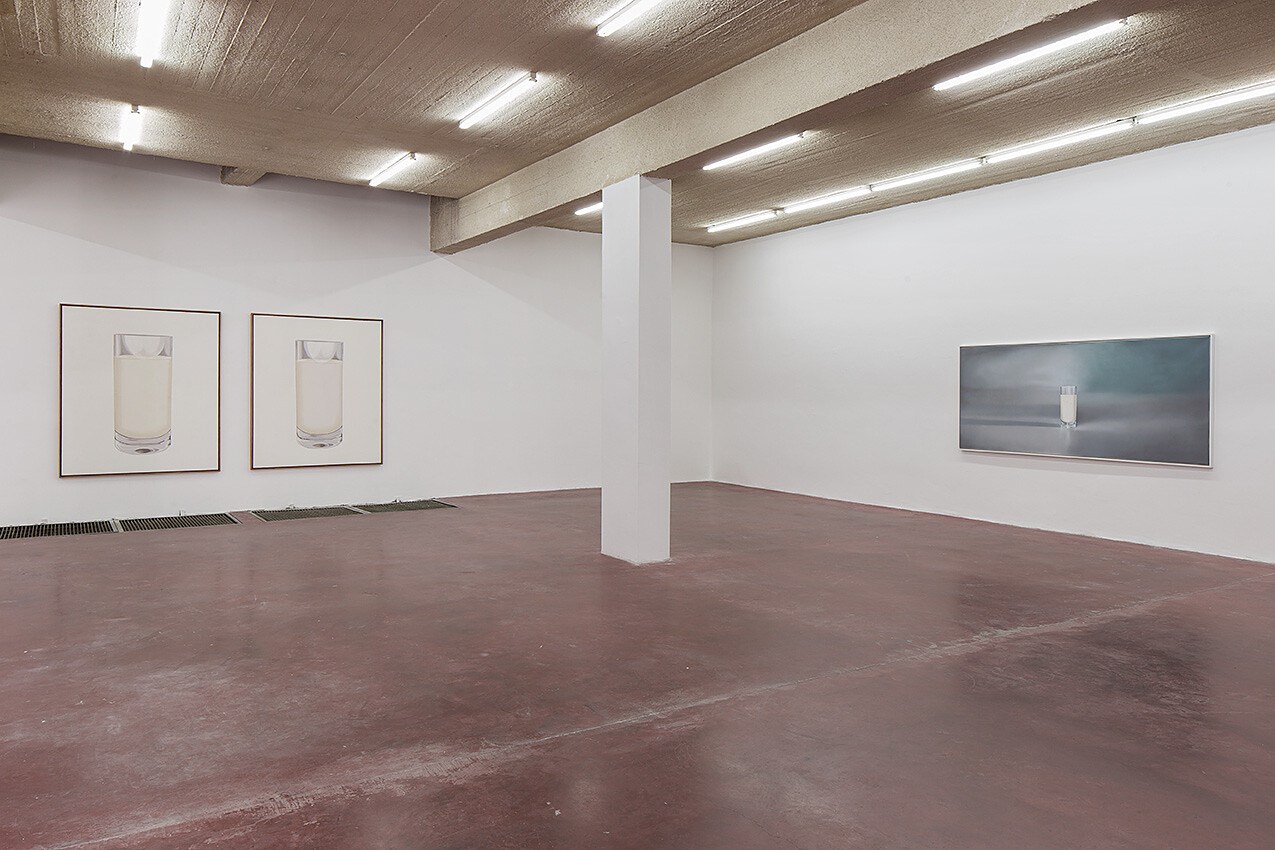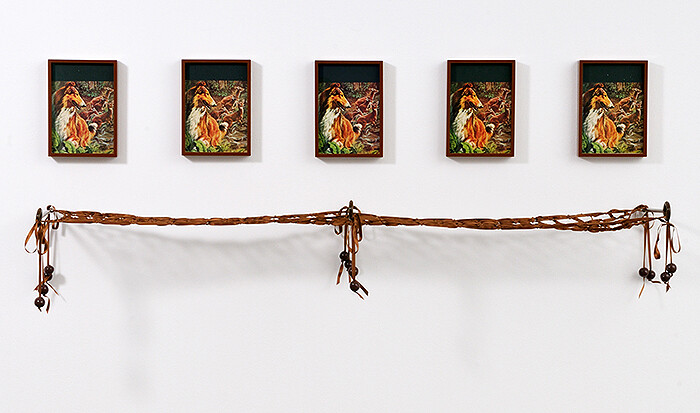Categories
Subjects
Authors
Artists
Venues
Locations
Calendar
Filter
Done
February 12, 2021 – Review
“‘Lacrimae Rerum,’ homage to Gustav Metzger – Part II”
Tal Sterngast

Memory, noted Marguerite Duras, is an attempt to escape the “horror of forgetting.” It is also, she argued, a failure: “You know you’ve forgotten, that’s what memory is.” The memory of the things we forget we call the unconscious. A group show at Tel Aviv’s Dvir Gallery, conceived in homage to Gustav Metzger and featuring works by Armando Andrade Tudela and Daniel Steegmann Mangrané alongside the late artist, traces the ways in which amnesia and memory constitute each other in the writing down of history.
At the center of “Lacrimae Rerum,” a lavish yellow fabric covers a large black-and-white photograph fixed to the industrial floor. This photograph from March 1938, part of Gustav Metzger’s “Historic Photographs” cycle and titled To Crawl Into - Anschluss, Vienna, March 1938 (1996–2020), has been enlarged to about thirteen square meters. It shows Jewish citizens in Vienna who were forced to clean the streets of the Austrian capital while Nazis and fellow citizens watched on, shortly after the Anschluss. In order to see this larger-than-life photograph, the viewer is required to crawl on all fours under the cloth, moving along the image’s surface, too close to comprehend it as a whole. The yellow fabric (as …
May 19, 2020 – Review
Sharif Waked’s “Balagan”
Orit Gat

The axiom that history is always written by the victors can be rejected by observing how different versions of it meet, merge, and are retold in shifting accounts that tell us as much about the present as the past. Sharif Waked’s work mediates between such versions. It does not explain or explore the histories of his homeland—Waked, born in 1964 in Nazareth to a Palestinian family who fled their hometown in 1948, is Palestinian by nationality and Israeli by citizenship—but confronts their clashing ideas of place, reminding viewers that pressing these versions of history can be an act of resistance. When the official version fails you, tell of that failure, again and again.
Waked works in several media, but his very short videos—often just a few seconds, always less than five minutes—set the tone and pace of the exhibition. By the entrance is a one-second video, Just a Moment No. 4 (Away From You) (2011), a black-and-white moving image of Egyptian singer Umm Kulthum stomping her foot while she sings. Under her elaborate dress, her high-heel goes up, then down, in an endless loop: a symbol of Middle Eastern culture in a motion associated with anxious waiting. Just a Moment work, …
May 3, 2017 – Review
“Placed Someplace with Intent”
Keren Goldberg

The number of Tel Avivan galleries mounting consecutive group shows is a symptom of the Israeli art market’s gloomy state. While you might assume that Dvir’s latest group exhibition—its second in a row—is another driven by commercial imperatives, it does draw concrete formal and contextual ties between works by major artists including Lawrence Weiner, Miroslaw Balka, Douglas Gordon, Shilpa Gupta, and Jonathan Monk.
Weiner’s Placed Someplace with Intent (2014), which gives the show its title, seems the most fitting of several text-based works in the show. The sentence might humorously describe Mircea Cantor’s sculpture Supposing I could hear that sound. Now (2015), a huge concrete coulisse adorned with thick concrete ropes, resting on two readymade shofars (ancient Jewish horns). The shofars peek out like two feet of a crushed, helpless creature. Cantor’s at times austere, at times whimsical use of readymades is also present in two works by Barak Ravitz, a promising young Israeli artist. In one, a black rubber cast of a raven is laying on the floor as if dead, its head resting on a black cotton thread ball that runs through its body (Knitter, 2016). It lies next to Cantor’s photograph Hiatus (2008), depicting a strange geometric wooden …
April 8, 2015 – Review
Simon Fujiwara’s “Lactose Intolerance”
Keren Goldberg

Milk production in two very different countries is the departure point of British-Japanese artist Simon Fujiwara’s solo show. North Korea does not produce any fresh milk, while Israel’s milk yield per cow is one of the highest in the world. In concordance with these facts, Fujiwara collaborated with two kinds of producers: North Korean painters employed by the Mansudae Art Studio, a state-run facility which manufactures propaganda imagery for the government, and cows from the Israeli kibbutz Ein Harod, a highly lucrative producer of milk.
Shown on one floor, seven paintings commissioned from the North Korean artists all depict the same glass of milk (“Lactose/Intolerance,” all works 2015). Their techniques vary, displaying the artists’ style range, from nostalgic through hyperrealist to early Pop. The techniques are impressive, but, as we can anticipate of paintings created as commodities on demand, they seem poster-like, lacking any real affect.
On another floor are a series of paintings made by cows, created by their excrement, which colored canvases positioned behind them during lactation (“No Milk Today”). The works are hung lower than the standard hanging height of an artwork, placed at the average cow’s eye level, and are unified in shape, size, and khaki shades. In …
July 14, 2014 – Review
“Apparition”
Daniel Horn

Apparitions, classified as celestial and flighty phenomena, spawn earthly suppositions from their beholder. And these thoughts can be utterly profane: Are Lassie and Bambi checking each other out, as Elad Lassry’s Collie (Deer) (2013) ensemble suggests? Wasn’t Bambi a minor? Wasn’t Lassie gay? What gender was Bambi supposed to be in the first place? Such are the less profound questions this multifaceted summer group show elicits, which in Lassry’s case hark back to the cherished wildlife from western pop culture. To this extent, both deer and collies are fully deserving of the same iconic lionization that their two-legged counterparts have enjoyed, like Marilyn Monroe or Elvis Presley, and subsequent Andy Warhol-worthy stars like Debbie Harry. As if transformed hands-on by Ikea’s creative team into something that resembles a wall-mounted, cassette-tape rack, Harry’s visage in Gregor Hildebrandt’s KSK Blondie (2014) materializes as neo-Pop-halftone-raster art.
Returning to Lassry’s typically sleek coated identity politics of just about everything—including what might be conspicuously bulbous Christmas decorations and an inconspicuous wave pattern in girlish, strawberry colored tones—one also passes by Alicja Kwade’s delicately quiet, golden watch hands. Stretching across four different iterations from a mere 12 hours, passing through 24 hours, then 48 hours until …